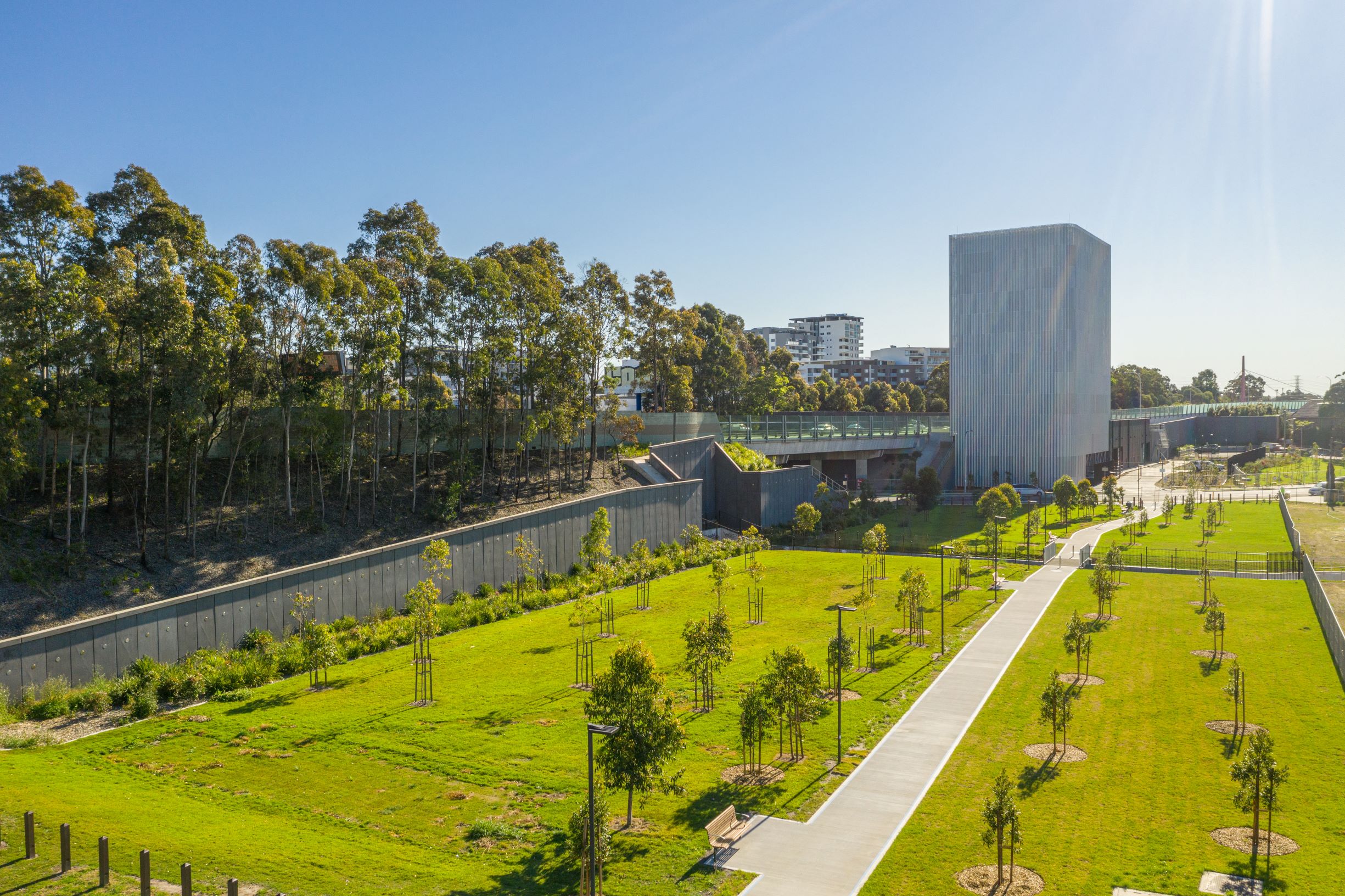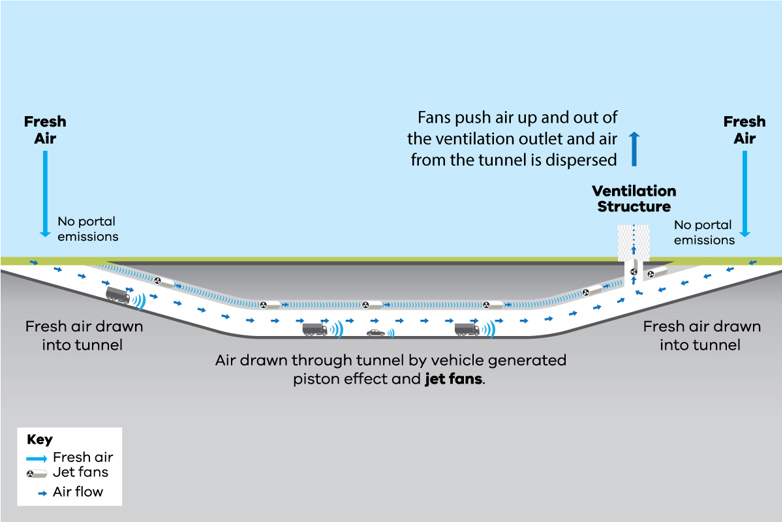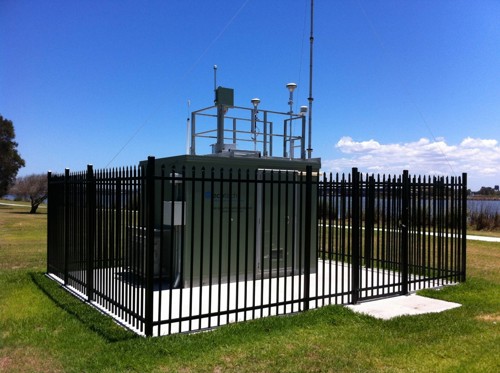Air quality

About air quality at WestConnex
WestConnex in-tunnel air quality monitoring program and ventilation systems have been designed to protect and improve the health of local communities and motorists using the tunnels.
Road tunnels can help reduce air pollution by moving traffic off of local roads and moving vehicles underground. A tunnel, compared to a local surface road, allows vehicle emissions to be controlled and dispersed more effectively. Air quality around tunnels is continually monitored to ensure standards are met.
You can find real time data on air quality for the New M4 Tunnels, the M5 East and WestConnex M8 here
Sydney’s Air Quality
By world standards, Sydney’s air quality is good, according to international comparisons by the World Health Organisation who set guidelines.
Even though traffic volumes have significantly increased over time, Sydney’s air quality has improved and is now cleaner than it was two decades ago. This is due to major improvements in vehicle emissions mainly due to stricter fuel and vehicle emission standards.
WestConnex and Air Quality
WestConnex is committed to effectively managing air quality during the construction and operation of the WestConnex road network. Tunnel infrastructure includes state-of-the-art technologies such as monitoring and ventilation facilities, which help keep air clean in our tunnels and nearby communities.
Air Quality was considered and assessed during the design of WestConnex. Tunnels are designed to be wider, flatter and higher than other tunnels in Sydney, meaning a smoother journey with less stop-start driving, relieving surface congestion and fewer vehicle emissions.
Monitoring and Reporting on Air Quality
In NSW air emissions are regulated by the NSW Environment Protection Authority (EPA), and compliance with ambient, or outdoor, air quality standards is an essential consideration during road project design and operation. To ensure requirements and standards are met, the WestConnex Project must be built and operated according to conditions placed on the project, which control air quality limits, monitoring and reporting.
These conditions are developed in consultation with the NSW Advisory Committee on Tunnel Air Quality, chaired by the NSW Chief Scientist and Engineer and including representatives from the NSW Environment Protection Authority, NSW Health, Roads and Maritime, and the Department of Planning and Environment as well as world-leading air quality experts.
Monitoring and reporting takes place to protect and work towards enhancing a local community’s air quality and to ensure the in-tunnel ventilation system is operating effectively.
To see our Air Quality reporting pages for each project – please see links below.
New M4 Tunnels Air Quality Reporting
WestConnex M8 Air Quality Reporting
M4-M5 Link Tunnels Air Quality Reporting
Air pollution in Australia is measured by six main air pollutants; carbon monoxide, nitrogen dioxide, photochemical oxidants, sulphur dioxide, lead and particulate matter. Of all the pollutants assessed, PM2.5 (tiny particles of matter, one-fortieth the width of a hair) is considered to present the greatest potential impact to our health. Accordingly, NSW standards for PM2.5 are the most stringent in the world.
Sydney is a major international centre with residential, commercial, industrial, and natural occurrences such as bush fires, all contributing to air pollution. Major contributors include wood heaters and home heating, contributing 51 per cent of PM2.5. Motor vehicles are an important contributor to emissions, contributing 14 per cent of PM2.5.
|
The in-tunnel air quality monitoring shows data for: |
The external ambient air quality monitoring shows data for |
The ventilation outlet air quality monitoring shows data for: |
|
Carbon monoxide (CO) Nitrogen dioxide (NO2) Visibility (K) |
Carbon monoxide (CO) |
Carbon monoxide (CO) Nitrogen dioxide (NO2) Oxides of nitrogen (NOx) Solid particles Volatile organic compounds (VOC) |
|
Nitrogen dioxide (NO2) |
||
|
Particles less than 2.5 micrometres in diameter (PM2.5) |
||
|
Particles less than 10 micrometres in diameter (PM10) |
||
|
Standard deviation in wind direction (Sigma theta) |
||
|
Temperature at 2 metres (ºC) |
||
|
Temperature at 10 metres (ºC) |
||
|
Wind direction (degrees) |
||
|
Wind speed (m/s) |
You can find a detailed description of each pollutant here
Ventilation systems work by drawing in fresh air from the tunnel entry, which is then pushed through the tunnel by the movement of vehicles and jet fans.
Before the tunnel exit, air is pushed up and out of the tunnel through a ventilation structure and high up into the atmosphere.
There are no emissions from the tunnel entries or exits where vehicles enter and exit. Research from around the world clearly shows emissions from well-designed tunnel ventilation systems have no measurable effect on local or regional air quality.

WestConnex systems feature ventilation structures located at the exit of each tunnel to remove air from inside the tunnel.
The system has been designed to:
- meet NSW’s stringent air quality requirements, which are among the highest standards in the world
- maintain safe air quality inside and outside the tunnel
- manage emissions from predicted traffic volumes now and long into future
Tunnel ventilation in NSW:
In NSW, all tunnels use ventilation systems. These systems have proven to be very effective. Before and after studies show that air quality remained consistently good after the tunnels opened, with no impact to local or regional air quality.
Air Quality Community Consultative Committees (AQCCC) have been established to provide input and advice on the location of air quality monitoring locations and related issues. The AQCCC for the New M4 Tunnels and the M8 were both established in 2017, and the AQCCC for the M4-M5 Link Tunnels and Rozelle Interchange were both established in 2021. Groups consist of local community members and council members who have a keen interest in their community and air quality.
The AQCCC’s role is to provide advice on the location of the air quality monitoring stations and to provide advice and input on the operation environmental management plans and other operational documents, compliance tracking reporting, audit reports, complaints relating to air quality, and dissemination of monitoring results, prior to and during the operation of the tunnels.
For more information, please refer to the below documents:
- M8 Terms of Reference
- New M4 Tunnels Terms of Reference
- M4-M5 Link Tunnels Terms of Reference
- Rozelle Interchange Terms of Reference
AQCCC meeting minutes can be found in the document library.
The AQCCC is not a decision-making or regulatory body, and instead performs an advisory and consultative role.
Air quality monitoring stations are installed along the WestConnex Project corridor to collect data in local areas on the surface. These stations help WestConnex keep track of what the air quality was prior to project approval, prior to project operation and after opening to ensure there has been no measurable impact on local air quality and to assess any changes.

External air quality in the suburbs adjacent to tunnels will vary during the year due to seasonal climate variations, wind speeds and external events such as dust storms, bush fires and construction works in the area. Due to external factors, air quality stations require monthly and sometimes weekly maintenance to ensure they are running correctly.
When there is an exceedance in air quality levels goals during a projects operational phase, a report is published online (see below table). To date, exceedances have largely been due to bush fires, dust storms and maintenance disruptions with the monitoring equipment.
|
What is being monitored? |
How? |
For how long? |
Where will results be published? |
|
Outside tunnel: Ambient or local air quality nearby the WestConnex project |
Ambient monitoring stations are placed in locations along and close to the project corridor |
Prior to approval; 12 months prior to operation; and For up to at least two years after the tunnels open |
|
|
Inside tunnel: Air quality in the tunnel and ventilation outlets |
Monitoring equipment inside the tunnel and ventilation outlets |
24/7, at all times during operation of the tunnels |
When a project is open and operating, data is available on the Linkt air quality website
|
For more information on air quality in NSW visit the NSW Department of Planning, Industry and Environment website for a daily update on Sydney's current and forecast air quality.

